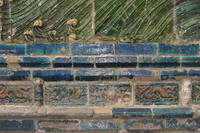Nine-Dragon Wall, Datong
unknown (Chinese)

Download1A2-CH-D-NDWD-A38_cp.jpg (720.6Kb)
Alternative Titles
九龙壁
Jiŭlóngbì
Date
1392Description
Detail of base (damaged and rebuilt) with different registers; top register under the large dragons; The number nine is special in China as it is the largest possible single digit, and Chinese dragons are frequently connected with it. The dragon, specifically yellow or golden dragons with five claws on each foot, was a symbol for the emperor in many Chinese dynasties. The Nine Dragon Screen at Datong was built in 1392. Intended to avert evil spirits, it originally stood in front of the palace of the viceroy of Shanxi Province, the 13th son of the Hongwu emperor (reigned 1368-1398); the palace burnt down in the mid-17th century. The screen is covered with glazed ceramic tiles in five colors. Just above the base are small figures of lions, tigers, elephants, qilin (mythical unicorn-like animals) and other animals, and above these are nine large dragons in high relief, rising from waves. The dragons all have four claws, used with imperial nobility and certain high-ranking officials. The top is shaped as a roof, with tiles and ridge acroteria. The screen was moved some 10 meters in 1954. Source: Grove Art Online; http://www.oxfordartonline.com/ (accessed 7/31/2012)
Type of Work
wall; relief (sculpture)Subject
animal, architecture, rulers and leaders, numerology, mythical beasts, Ming
Rights
Rights Statement
Licensed for educational and research use by the MIT community only